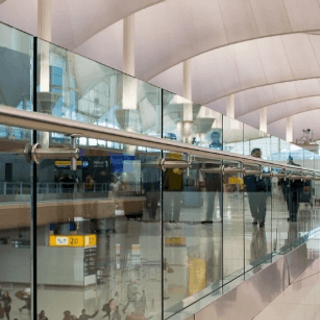Guardrails and handrails are important safety features in any building, providing support and stability on stairs, balconies, walkways, and ramps. Understanding the distinction between guardrail vs handrail applications is key for both safety and OSHA compliance. The Occupational Safety and Health Administration (OSHA) is tasked with setting guidelines that help ensure employee safety and health. OSHA’s standards are made with the goal of assuring “America’s workers have safe and healthful working conditions free from unlawful retaliation,” according to the OSHA website.
To achieve this mission, OSHA sets and enforces standards for worker safety and health protections. While guardrails and handrails are similar, they serve distinct purposes in a workplace. When comparing guardrail vs handrail, OSHA outlines different requirements based on their function and placement. Please consult the OSHA standards and a contractor when designing and constructing an OSHA compliant building.
OSHA Guardrail Requirements
OSHA guardrail requirements are intended to create a safe walking-working surface for all employees. Notable requirements are found in section 1910.29(b) and are as follows:
- The top edge height of top rails must be 42 inches, plus or minus three inches, above the walking-working surface.
- If the guardrail system meets all other criteria in section 1910.29(b), the top rail is permitted to be as high as 45 inches.
- When there is not a wall or parapet at least 21 inches high:
- Infill, including midrails, screens, mesh, intermediate vertical members, solid panels, or equivalent must be installed between the walking-working surface and the top edge of the guardrail system.
- Midrails must be installed at a height midway between the top edge of the guardrail system and the walking-working surface.
- Intermediate vertical members must be installed no more than 19 inches apart.
- Guardrail systems must be able to withstand, without failure, a force of at least 200 pounds applied in a downward or outward direction within 2 inches of the top edge, at any point along the top rail.
- Guardrail systems must be smooth and free of projections that could cause punctures or lacerations or catching or snagging of clothing.
- Top rails and midrails must be at least 0.25-inches in diameter or in thickness.
- Guardrails must be installed along each unprotected side of ramps and runways
OSHA also lays out additional guardrails requirements for areas where materials will be passed through a hole and when guardrail systems are used around holes.
OSHA Handrail Requirements
Guards are present to prevent employees from falling off of elevated areas, but handrails are necessary to provide support as employees move along ramps or up and down staircases. Guardrail vs handrail height requirements are different to ensure each railing is performing its designated function. OSHA requirements for handrails are found in section 1910.29(f) and include (but are not limited to):
- Handrails must be at least 30 inches and not more than 38 inches as measured from the leading edge of the stair tread to the top surface of the handrail
- Stair rail systems installed on or after January 17, 2017 must have a height not less than 42 inches as measured from the leading edge of the stair tread to the top surface of the handrail.
- The top rail of the rail system can serve as a handrail only when:
- The height of the stair rail system is not less than 36 inches and not more than 38 inches as measured per the previous standards.
- There must be a minimum clearance of 2.25 inches between handrails and any other objects.
- Handrails and stair rails must be smooth-surfaced.
- No stair rail opening can exceed 19 inches.
- Handrails must have the shep and dimension necessary so employees can grasp it firmly.
- The ends of the handrail system cannot present any projection hazards.
- Handrail systems must be capable of withstanding, without failure, at least 200 pounds of force applied in a downward or outward direction within 2 inches of any point along the top edge of the rail.
OSHA Requirements in Action
Seeing OSHA requirements in action can help you visualize how compliance with the standards will impact the visual appearance of the design.
In this design, for instance, the railing system isn’t on a staircase or ramp, so it doesn’t require a handrail. Because it acts as a guard this system must be at least 42 inches, plus or minus 3 inches, above the walking surface. It also includes a mesh infill which, on walking-working surfaces, would need to extend from the walking-working surface to the top rail and along the entire opening between top rail supports. Because this area is horizontal for walking, the infill isn’t required to fill the entire opening.
For horizontal cable or multiline railing systems, OSHA requires a midrail installed at a height that is midway between the top edge of the guardrail and the walking-working surface. This multiline infill design features single flat bar posts that offer low maintenance and high visibility. This is another instance where a guardrail vs handrail is the best solution.
OSHA standards require that railings that intermediate vertical members must be no more than 19 inches apart. In addition, top rails and midrails must be at least 0.25 inches in diameter or in thickness in order to comply with OSHA standards. Handrails can’t be less than 30 inches or more than 38 inches above the walking-working surface.
Comply with OSHA Standards with Help from VIVA Railings
VIVA Railings offers a range of systems that can comply with OSHA standards and protect employees in their workplace. We make code compliance easy and will ensure that your design meets safety requirements while looking beautiful.
Contact the experts at VIVA Railings today to discuss how OSHA requirements will impact your project and how we can help you meet them.


